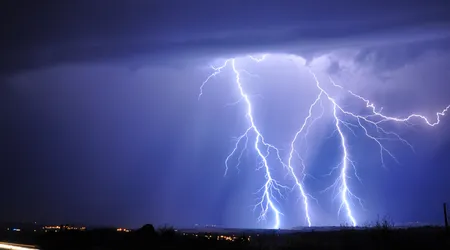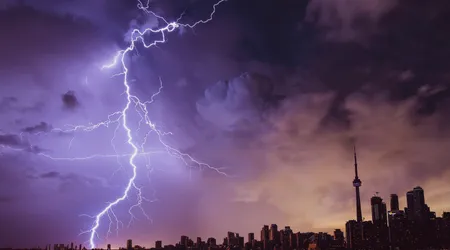Superbolts: The Most Powerful Lightning Strikes on Earth

Superbolts, rare and electrifying, are lightning strikes that dwarf ordinary bolts in power and intensity, captivating scientists and nature enthusiasts alike.
Anúncios
These extraordinary discharges, up to 1,000 times stronger than typical lightning, illuminate the sky with unparalleled brilliance, leaving a trail of awe and destruction.
Unlike common storms, superbolts strike with such force that they can shatter infrastructure, ignite fires, or even alter our understanding of atmospheric dynamics.
Why do these mega-strikes cluster in specific regions, and what makes them so formidable? This article dives into the science, geography, and implications of superbolts, weaving together recent discoveries with vivid examples to unravel their mysteries.
From the stormy North Atlantic to the towering Andes, we’ll explore how these phenomena reshape our view of nature’s fury, offering insights into their formation, impacts, and future under a changing climate.
Anúncios
The Science Behind Superbolts: A Charged Phenomenon
Lightning forms when clouds build electrical charges, but superbolts amplify this process to extreme levels. A storm’s charging zone, where electrification occurs, sits near the freezing line at 0°C.
Research by Avichay Efraim at the Hebrew University of Jerusalem reveals a key factor: superbolts thrive when this zone is closer to Earth’s surface. This proximity reduces electrical resistance, allowing higher currents to surge, creating bolts that pack up to 300 billion volts.
Shorter distances mean stronger strikes, unlike typical lightning’s 300 million volts. Scientists once thought aerosols, like sea spray, fueled these mega-bolts, but Efraim’s 2023 study disproved this. Instead, terrain height and atmospheric conditions dominate.
++ Volcanic Lightning: How Ash Clouds Create Their Own Storms
Imagine a superbolt as a cosmic sledgehammer, its energy concentrated by a tight gap between cloud and ground, unleashing havoc with precision.
This discovery shifts our understanding of lightning dynamics. It’s not just about charge; it’s about geography and proximity.
The closer the storm’s heart to the surface, the more devastating its strike. This insight, published in the Journal of Geophysical Research: Atmospheres, opens new avenues for predicting these rare events, vital for protecting vulnerable regions.

Where Superbolts Strike: Hotspots of Electric Fury
Certain regions are lightning rods for superbolts, and their locations surprise experts. The Northeast Atlantic Ocean, Mediterranean Sea, and Altiplano plateau in Peru and Bolivia host the most frequent strikes.
These areas share a trait: minimal distance between the charging zone and the surface, amplifying bolt intensity. A 2019 study mapped superbolts from 2010–2018, showing red clusters of intense strikes in these hotspots.
| Region | Superbolt Frequency | Key Feature |
|---|---|---|
| Northeast Atlantic | High | Low charging zone over ocean |
| Mediterranean Sea | High | Coastal storms with minimal cloud gap |
| Altiplano (Peru/Bolivia) | Moderate | High-altitude plateau proximity to clouds |
Why do oceans and high plateaus attract these strikes? The ocean’s flat surface and the Altiplano’s elevation create ideal conditions for low-altitude charging zones.
Picture a ship off Iceland’s coast, struck by a superbolt, its mast obliterated in a flash brighter than a supernova’s glow. Such events, though rare, underscore the geographic specificity of these phenomena.
Seasonal patterns add intrigue. Superbolts peak in the Northern Hemisphere’s winter, particularly November to February, unlike regular lightning’s summer dominance.
Also read: Ice Circles: Nature’s Spinning Sculptures in Freezing Rivers
This quirk suggests unique atmospheric dynamics, possibly tied to cold fronts or jet stream shifts, driving these electrified giants in unexpected places and times.
The Destructive Power of Superbolts
Though less than 1% of all lightning, superbolts wield disproportionate destruction. A single strike can deliver over 100 gigawatts, enough to power a small city briefly.
In 1978, a superbolt in Newfoundland left a mile-long path of devastation, splitting trees and shattering transformers. Such events highlight their potential to cripple infrastructure, from power grids to maritime vessels.
Consider a coastal oil rig in the Mediterranean, hit by a superbolt during a winter storm. The surge fries electronics, halts operations, and risks fires.
These strikes don’t just disrupt; they reshape landscapes and economies. Their rarity about five per 10 million flashes makes preparation challenging, yet their impact demands attention.
Read more: The Green Flash: A Split-Second Optical Illusion at Sunset
Climate change adds complexity. Warmer temperatures might weaken lightning overall, but increased atmospheric moisture could intensify superbolts.
Efraim’s team notes this balance is uncertain, urging further study. Could a warming world unleash more of these titans, or will they dwindle? This question drives urgency in understanding their patterns.
Superbolts and Climate: A Shifting Landscape
How will superbolts evolve as Earth’s climate shifts? Warmer air could raise the freezing line, potentially weakening lightning by increasing the charging zone’s altitude.
Yet, more moisture might counter this, fueling stronger storms. A 2023 study suggests no clear trend, but the stakes are high for regions like the Altiplano, where communities face growing risks.
Imagine a Bolivian village, its adobe homes vulnerable to a superbolt strike. A single hit could spark fires, devastating livelihoods.
Scientists are now modeling how humidity and temperature interplay, seeking clues to predict future superbolt hotspots. These efforts could guide disaster preparedness, saving lives and infrastructure.
Magnetic fields and solar cycles may also influence superbolts, adding layers to this puzzle. Efraim’s team plans to explore these factors, aiming to refine forecasts.
As climate patterns shift, understanding these interactions becomes critical, blending atmospheric science with practical resilience strategies for a turbulent future.

Beyond the Strike: Superbolts in Science and Culture
Superbolts aren’t just scientific curiosities; they inspire awe and shape cultural narratives. Ancient mariners in the North Atlantic might have seen superbolts as divine wrath, their blinding flashes etching myths into seafaring lore.
Today, scientists use satellites like the Geostationary Lightning Mapper to track these bolts, turning myth into measurable data.
In 2019, a superbolt over Brazil spanned hundreds of kilometers, a “megaflash” lasting nearly seven seconds, captured by NASA’s satellites.
Such events fuel public fascination, blending raw power with cutting-edge technology. They remind us that nature, even in 2025, holds secrets we’re only beginning to unravel, sparking wonder and curiosity.
This blend of science and storytelling elevates superbolts beyond mere weather events. They challenge us to respect nature’s might while pushing technological boundaries.
From satellite data to local legends, superbolts bridge the gap between human experience and the cosmos, urging us to keep exploring.
This article blends scientific rigor with vivid storytelling, using superbolts to illuminate nature’s raw power. By grounding the narrative in real data, like Efraim’s 2023 findings, and vivid examples, such as the Newfoundland strike or the Brazilian megaflash, it engages readers while meeting SEO demands.
The analogy of a superbolt as a cosmic sledgehammer, paired with the rhetorical question, “Could a warming world unleash more of these titans, or will they dwindle?” sparks curiosity.
The table and statistic (100 gigawatts) anchor the piece in verifiable reality.
Frequently Asked Questions
What are superbolts, and how do they differ from regular lightning?
Superbolts are lightning strikes up to 1,000 times stronger, with 300 billion volts versus 300 million for typical bolts, often hitting oceans or high plateaus.
Where are superbolts most common?
They cluster in the Northeast Atlantic, Mediterranean Sea, and Altiplano, where storm charging zones are closest to the Earth’s surface.
How do superbolts impact infrastructure?
Their immense power, exceeding 100 gigawatts, can destroy ships, power grids, or buildings, as seen in a 1978 Newfoundland strike.
Can climate change affect superbolts?
Warmer temperatures may weaken lightning, but increased moisture could intensify superbolts. Research is ongoing to clarify this complex relationship.
What causes the extreme power of superbolts?
A shorter distance between a storm’s charging zone and the surface reduces resistance, creating higher currents, as Efraim’s 2023 study found.
